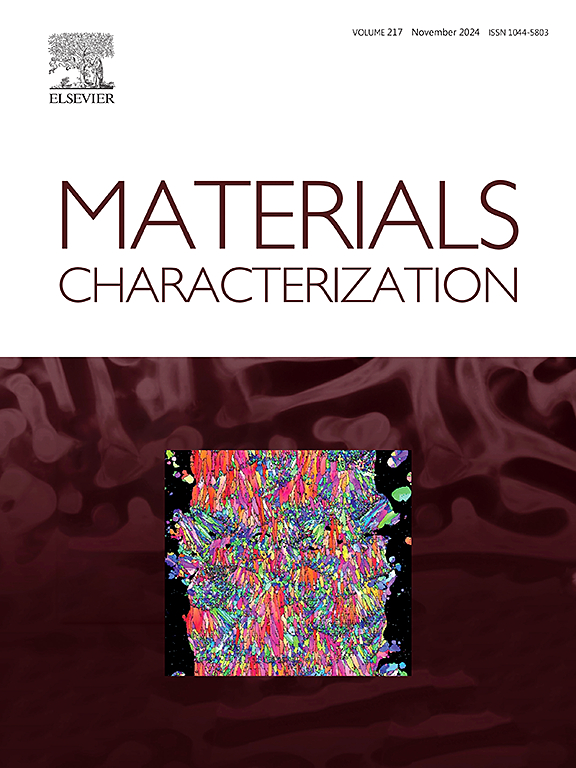Reduction of compression-tension yield asymmetry in binary MgGd alloys via mastering their crystallographic textures
IF 4.8
2区 材料科学
Q1 MATERIALS SCIENCE, CHARACTERIZATION & TESTING
引用次数: 0
Abstract
Compression-tension asymmetry (CTA) in yield strength is one of the issues that hinders widespread application of wrought Magnesium (Mg) alloys. Strong basal texture formed in thermomechanical processing and the difference in activation of deformation twinning in tension and compression are responsible for CTA. To reduce CTA, the readily implementable Double Equal Channel Angular Pressing (D-ECAP) is used in this study for altering the microstructure and texture of Mg samples. Mg bars containing 1, 5, and 10 wt% Gd were subjected to D-ECAP at 400 °C. Due to plastic strain, the average grain sizes decreased from several hundred microns to about 13.4 μm, 5.6 μm, and 5.1 μm, respectively. All processed samples showed high strength and characteristics shear textures. The crystallographic textures displayed the so-called C1-C2 and B fibers. C1-C2 were the major fibers in the 1 % and 5 % Gd samples, while the B and C1 fibers appeared in the 10 % Gd sample. C1-C2 requires high activity of pyramidal <c + a > slip, and B belongs to basal slip. The CTA was measured by the ratio of the compression/tensile yield stress and significant increase in CTA was obtained on the D-ECAP processed samples with respect to the base alloys. The CTA reached 0.85 in the Mg![]() 10Gd alloy without sacrificing the yield strength. Polycrystal plasticity simulations were done using the experimental textures and good reproduction of the CTA values were achieved. The simulation results also revealed the relative activity of the slip and twinning systems for understanding the mechanisms that control the CTA. The results of this study revealed that D-ECAP is an efficient processing technology that can be widely used in the preparation of high-performance Mg
10Gd alloy without sacrificing the yield strength. Polycrystal plasticity simulations were done using the experimental textures and good reproduction of the CTA values were achieved. The simulation results also revealed the relative activity of the slip and twinning systems for understanding the mechanisms that control the CTA. The results of this study revealed that D-ECAP is an efficient processing technology that can be widely used in the preparation of high-performance Mg![]() Gd alloys.
Gd alloys.
通过控制二元MgGd合金的晶体织构来降低合金的压拉屈服不对称性
屈服强度的压拉不对称是制约变形镁合金广泛应用的问题之一。热加工过程中形成的强基底织构以及拉伸和压缩变形孪晶激活的差异是CTA的主要原因。为了减少CTA,本研究中使用了易于实现的双等通道角压(D-ECAP)来改变Mg样品的微观结构和织构。含有1、5和10 wt% Gd的Mg棒在400°C下进行D-ECAP。由于塑性应变的作用,平均晶粒尺寸从几百μm减小到13.4 μm、5.6 μm和5.1 μm左右。处理后的样品均表现出较高的强度和剪切纹理特征。晶体结构显示了所谓的C1-C2和B纤维。1%和5% Gd样品中以C1 ~ c2纤维为主,10% Gd样品中以B和C1纤维为主。C1-C2需要高活性锥体<;c + a >;B属于基底滑移。通过压缩屈服应力/拉伸屈服应力的比值测量CTA,发现D-ECAP处理样品的CTA明显高于基体合金。在不牺牲屈服强度的情况下,Mg10Gd合金的CTA达到0.85。利用实验织构进行了多晶塑性模拟,得到了较好的CTA值再现。模拟结果还揭示了滑移和孪生系统的相对活性,以了解控制CTA的机制。研究结果表明,D-ECAP是一种高效的加工技术,可广泛应用于高性能MgGd合金的制备。
本文章由计算机程序翻译,如有差异,请以英文原文为准。
求助全文
约1分钟内获得全文
求助全文
来源期刊

Materials Characterization
工程技术-材料科学:表征与测试
CiteScore
7.60
自引率
8.50%
发文量
746
审稿时长
36 days
期刊介绍:
Materials Characterization features original articles and state-of-the-art reviews on theoretical and practical aspects of the structure and behaviour of materials.
The Journal focuses on all characterization techniques, including all forms of microscopy (light, electron, acoustic, etc.,) and analysis (especially microanalysis and surface analytical techniques). Developments in both this wide range of techniques and their application to the quantification of the microstructure of materials are essential facets of the Journal.
The Journal provides the Materials Scientist/Engineer with up-to-date information on many types of materials with an underlying theme of explaining the behavior of materials using novel approaches. Materials covered by the journal include:
Metals & Alloys
Ceramics
Nanomaterials
Biomedical materials
Optical materials
Composites
Natural Materials.
 求助内容:
求助内容: 应助结果提醒方式:
应助结果提醒方式:


